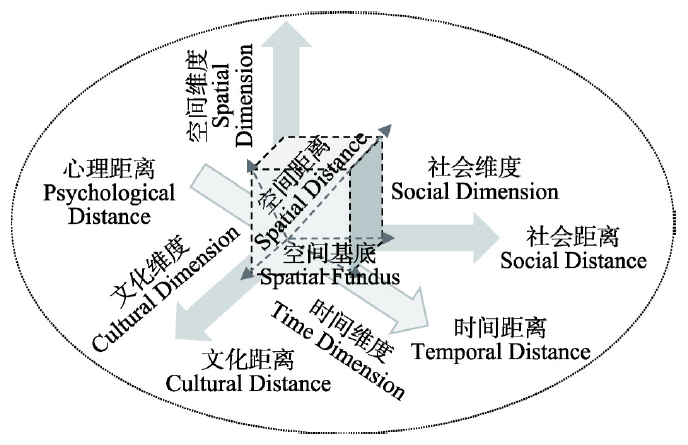

距离欲对旅游者目的地选择影响的解释框架
|
曹晶晶(1987-), 女, 山东临邑人, 博士, 讲师, 研究方向为旅游规划与管理。E-mail: jingjing_cao@foxmail.com |
收稿日期: 2018-06-07
要求修回日期: 2019-08-31
网络出版日期: 2020-06-25
基金资助
国家自然科学基金项目(41771147)
版权
Exploring the essence of distance: A framework of distance desire and tourist destination choice
Received date: 2018-06-07
Request revised date: 2019-08-31
Online published: 2020-06-25
Supported by
National Natural Science Foundation of China(41771147)
Copyright
距离是影响人类各种空间行为的重要因素,也是探索旅游者行为规律的重要变量。然而,现有的旅游者目的地决策模型多将其作为约束条件处理,充分讨论了距离的阻力机制,却忽视了对其引力机制的探索,也因此导致了理论与营销实践层面的不足。本文提出“距离欲”来表述距离的引力作用,基于其审美情感基本属性,将其细分为认知维度、情感维度和旅游动机维度3个维度;根据旅游者旅游审美需求特点,从现代性审美视角切入,将其细分为游戏的距离欲、时尚的距离欲、冒险的距离欲3个层次,并进行了理论阐述。研究进一步指出,距离欲是旅游者对距离意义的解读,距离欲概念的提出为旅游者外出旅游的动机提供了新的解释,旅游者对诗意“远方”的追求,是旅游者基本的审美需求,也是人类超越自我的本质追求,还是高速发展的流动性社会中个体抵御异化的审美救赎。距离欲同时为我们进一步认识旅游的本质提供了新的解读视角,旅游活动带来的距离的审美体验能够参与建构和重塑旅游者的心理结构,在帮助旅游者更好的重返现实世界的同时,还积极的促进旅游者以和谐、宽容、独立的美学境界来重塑现实世界。本文从距离视角切入,进一步证实了旅游活动在旅游者个体、群体乃至全人类生存品质提升过程中所发挥的积极作用。通过对距离欲与其他行为变量的关系的进一步梳理,最终形成了距离与旅游者目的地选择的基本解释框架。对距离欲的深入探索能够为全球化的流动时代下旅游者外出旅游动机分析提供新解释,为旅游本质的解读提供新线索,具有一定的理论意义;同时为进一步提升旅游者目的地选择模型的解释力与预测力提供了可能性,为目的地营销机构针对感知距离的精准营销战略的制定提供新思路,具有一定的实践意义。

曹晶晶 , 章锦河 , 王昶 , 孙晋坤 , 陈敏 . 距离欲对旅游者目的地选择影响的解释框架[J]. 地理学报, 2020 , 75(4) : 860 -877 . DOI: 10.11821/dlxb202004014
Distance is an important factor influencing all kinds of human spatial behavior and is also a major variable in exploring the laws of human behavior. However, the existing tourist destination decision model treats distance as a constraint condition, comprehensively discussing the frictional effect while ignoring the impacts of the catalytic effect of distance. This has led to a lack of theoretical and marketing practices. This study proposes the concept of distance desire to express the catalytic effect of distance. Based on its basic attribute of aesthetic emotion, the concept is subdivided into three dimensions: the cognitive dimension, the emotional dimension, and the travel motivation dimension. According to the characteristics of tourists' aesthetic demands, distance desire has been divided into three levels from the perspective of the modern aesthetic view, including the distance desire of game, distance desire of fashion and distance desire of adventure. The study further points out that distance desire is a tourist's interpretation of the meaning of distance. The development of distance desire provides a new explanation for tourist's motivation to travel. The pursuit of the poetic "far-away" by tourists is the essential pursuit of human beings to surpass themselves and is also an aesthetic salvation of individual resistance to alienation in a rapidly developing fluid society. Distance desire also provides a new perspective for understanding the essence of tourism. The aesthetic experience of the distance brought by tourism activities can satisfy the tourists' spiritual pursuit of harmony (differentiating the divisions caused by daily life), tolerance (differentiating respect and recognition) and independence (free construction of personality). Tourism is a form of aesthetic experience, during which tourists participate in constructing and reshaping their psychological structure, thus encouraging them to return to the real world and to reshape it within a harmonious, tolerant and independent aesthetic realm, thereby enhancing the quality of life of tourists individually and of humanity as a whole. By further discussing the relationship between distance desire and other behavioral variables, the basic interpretation framework of distance and tourist destination choice is eventually provided in this study. An in-depth study of distance desire can provide new explanations for the analysis of the tourist motivations in the era of globalization, provide new clues for the interpretation of the essence of tourism, provide a new understanding of the law of distance decay in tourist destination choice from a micro-individual perspective, provide possible theoretical explanations for a more comprehensive understanding of the distance dynamics in tourists' destination choices, provide the possibility to further improve and enhance the explanatory power and the predictability of the tourist destination decision model, and provide destination marketing organizations (DMOs) new ideas to develop targeted marketing strategies concerning cognitive distance.

表1 距离欲与距离、感知距离的概念辨析Tab. 1 Differential analysis of the concepts of physical distance, cognitive distance and distance desire |
| 比较内容 | 距离 | 感知距离 | 距离欲 |
|---|---|---|---|
| 主体 | - | 旅游者 | 旅游者 |
| 客体 | 旅游者居住地与旅游目的地 | 旅游者居住地、旅游目的地 | 旅游者居住地与旅游目的地的距离 |
| 内容 | 旅游者居住地与旅游目的地空间实际距离 | 旅游者居住地与旅游目的地空间实际距离的认知评价 | 旅游者居住地与旅游目的地空间认知距离的情感评价 |
| 目的 | 客观描述旅游者居住地与旅游目的地的相对位置 | 旅游者对居住地与旅游目的地相对位置的空间认知与评价(距离远——近的判断) | 旅游者对居住地与旅游目的地相对位置的空间认知的情感评价(距离远近带来的吸引力——阻碍的判断) |
| 意义 | ① 客观描述空间中客源地与旅游目的地之间的空间关系;② 探索旅游者行为空间规律的基本变量 | ① 反映旅游者对居住地与旅游目的地远——近的认知;② 探索旅游者空间认知规律的基本变量 | ① 反映旅游者对距离所产生的引力或阻力的情感认知与判断(对距离远近所带来的未知的向往或逃离);② 直接作用于旅游者目的地选择、用于探索距离作用机制的基本变量;③ 探索距离对旅游者的意义的基本变量 |
| [1] |
|
| [2] |
|
| [3] |
|
| [4] |
|
| [5] |
|
| [6] |
|
| [7] |
|
| [8] |
|
| [9] |
[ 王岚, 张捷, 曹靖 , 等. 九寨沟旅游者感知距离偏差研究. 北京第二外国语学院学报, 2009,31(5):54-59.]
|
| [10] |
|
| [11] |
[ 曹晶晶, 章锦河, 周珺 , 等. “远方”有多远? 感知距离对旅游目的地选择行为影响的研究进展. 旅游学刊, 2018,33(7):103-118.]
|
| [12] |
|
| [13] |
|
| [14] |
|
| [15] |
[ 张宏磊, 张捷, 史春云 , 等. 感知距离与游客满意度影响关系研究. 人文地理, 2011,26(5):117-120.]
|
| [16] |
[ 解杼, 张捷, 刘泽华 , 等. 旅游者入游感知距离与旅游空间行为研究: 以江西省龙虎山为例. 安徽师范大学学报(自然科学版), 2003,26(4):395-400.]
|
| [17] |
[ 魏鹏, 石培基, 杜婷 . 基于空间意象的旅游者空间决策过程研究. 旅游学刊, 2015,30(9):43-51.]
|
| [18] |
[ 张宏梅, 陆林, 章锦河 . 感知距离对旅游目的地之形象影响的分析: 以五大旅游客源城市游客对苏州周庄旅游形象的感知为例. 人文地理, 2006,21(5):25-30.]
|
| [19] |
|
| [20] |
[ 大卫·哈维 . 世界的逻辑. 周大昕, 译. 北京: 中信出版集团, 2017: 127-154.]
|
| [21] |
|
| [22] |
|
| [23] |
|
| [24] |
|
| [25] |
|
| [26] |
|
| [27] |
|
| [28] |
[ 杨向荣 . 现代性和距离: 文化社会学社会学视域中的齐美尔美学. 北京: 社会科学文献出版社, 2009: 124.]
|
| [29] |
[ 约翰·赫伊津哈 . 游戏的人: 文化中游戏成分的研究. 何道宽, 译. 广州: 花城出版社, 2017.]
|
| [30] |
[ 康德 . 美, 以及美的反思: 康德美学全集. 曹俊峰, 译. 北京: 金城出版社, 2013: 461-464.]
|
| [31] |
|
| [32] |
[ 齐奥尔格·西美尔 . 时尚的哲学. 费勇, 吴晏, 译. 北京: 文化艺术出版社, 2001.]
|
| [33] |
|
| [34] |
[ 戴维·弗里斯 . 现代性的碎片: 齐美尔、克拉考尔和本雅明作品中的现代性理论. 卢晖临, 周怡, 李林艳, 译. 北京: 商务印书馆, 2013.]
|
| [35] |
[ 齐奥尔格·西美尔 . 生命直观. 刁承俊, 译. 北京: 三联书店, 2003.]
|
| [36] |
[ 达默尔 . 真理与方法: 哲学诠释学的基本特征(上卷). 洪汉鼎, 译. 上海: 上海译文出版社, 1999: 88-89.]
|
| [37] |
[ 周宪 . 美学是什么. 北京: 北京大学出版社, 2015.]
|
| [38] |
|
| [39] |
|
| [40] |
|
| [41] |
|
| [42] |
|
| [43] |
|
| [44] |
Chien,
|
| [45] |
|
| [46] |
|
| [47] |
|
| [48] |
|
| [49] |
|
| [50] |
|
| [51] |
|
| [52] |
[ 张朝枝, 张鑫 . 流动性的旅游体验模型建构: 基于骑行入藏者的研究. 地理研究, 2017,36(12):2332-2342.]
|
| [53] |
|
| [54] |
|
/
| 〈 |
|
〉 |